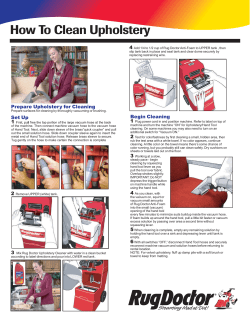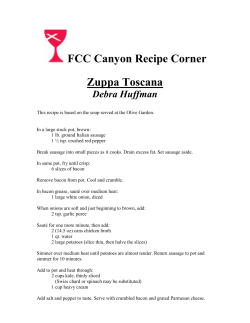
How to Clean the Harman Accentra
How to Clean the Harman Accentra Here are step-by-step instructions for cleaning your Harman Accentra Pellet Stove. Please read through this guide before starting. These instructions are to be used in conjunction with the owner’s manual that came with your stove. If you have any questions about the procedure please don’t hesitate to call your local dealer. In order to maintain top efficiency it is important to clean and vacuum the inside of the stove 3 or 4 times per burn season or once per ton of pellets burned (you will know you have burned a ton of pellets when the ash pan is full). The stove is designed to be very easy to clean, it should take about an hour to an hour and a half to do a good job. A thorough cleaning is required at the end of each heating season. Keep in mind that cleaning both your insert and venting system is essential. Cleaning boosts heat output and keeps the stove running at maximum efficiency. Many Harman dealers offer annual cleaning services for their customers. TOOLS YOU WILL NEED: Dust Mask & Safety Goggles Shop vacuum w/fine dust (HEPA) filter Standard socket set or nut driver set Tooth brush Flexible brush that came with your stove 3 in. flexible brush (for vent pipe) Burn pot scraper (included w/stove) Paper towels Rubber gloves (soot really gets into pores) Drop cloth Flashlight or drop light 3” to 4” paintbrush for cleaning Small putty knife Hearth glass cleaner TIPS BEFORE YOU START: Be sure the stove is completely out and cool (and unplugged from electrical power!). The stove must be completely out before cleaning. Every part must be cool to the touch, including the pellets that are left in the burn pot. Live pellets are a fire hazard – especially if they get sucked into a vacuum cleaner. Every year there are stories of house vacuums catching fire by inadvertently sucking up hot ashes. Worse still this can be the source of a house fire! Hot ashes should be stored in a metal container with a tight fitting lid. When the ashes are completely out they can be used as a soil conditioner for your lawn or garden. Wear a dust mask! This is important! Don’t be foolhardy when it comes to protecting your lungs (Fig. 1). Wear a mask and protective goggles. Professional chimney sweeps wear both while performing cleaning tasks. Fig. 1 STEP #1: PREPARE THE WORK AREA Start by placing a drop cloth on the floor in front of your stove. Alternatively you can use newspaper. Keep your tools on the drop cloth so you can wrap them in it and take them outside for cleaning when you are done. STEP #1: REMOVE SOOT DEPOSITS FROM WITHIN THE BURN POT WITH THE VACUUM. Remove the flame guide and vacuum the ash from the burn pot and above the burn pot (Fig. 2). Fig. 2 STEP #2: CLEAN THE BURN POT USING THE SCRAPER PROVIDED Use the flat end of the scraper to remove the carbon from the burn pot (Fig. 3). Alternatively use a hammer and a straight tip screw driver to tap the deposits loose. When the burn pot has been scraped, use a vacuum to remove the ash and carbon deposits. Remove the ash pan from the stove (Fig. 4), dump out the ashes and clean out the interior and exterior. Vacuum the lower area of the firebox while the ash pan is removed. Fig. 3 Fig. 4 STEP #3: CLEAN ASH FROM INSIDE THE BURN POT Remove the clean out plate under the burn pot by loosening the two wing nuts holding the plate in place (Fig. 5). You many need to use pliers to loosen the wing nuts initially and then vacuum ash from the inside of the pot. Use your finger to brush out any ash that can’t be reached with the nozzle of the vacuum. After cleaning, be sure the plate is fully closed before hand tightening the wing nuts. (Note: You don’t need to tighten the wing nuts with pliers.) Fig. 5 STEP #4: REMOVE THE HEAT EXCHANGER CHANNEL COVERS Remove the channel covers from the firebox by the sides of the “compass”. Turn the swing latches at the upper right and left of the baffles (Fig. 6) and lift slightly on the cover in order to remove them. Fig. 6 STEP #5: NEXT REMOVE THE COMBUSTION INTAKE BLOWER COVER Remove the combustion intake blower cover. The combustion intake housing assembly is held in place with two swing latches (Fig. 7). Swing each latch until it hangs down away from the retainer stud. Once the latches are free, swing the right side of the cover out and clear of the door frame then pull the housing out on a diagonal. Fig. 7 STEP #6: CLEAN THE HEAT EXCHANGER AREA BEHIND THE HEAT EXCHANGER CHANNEL COVERS AND THE SIDE INTERIOR WALLS. Using the pointed end of the burn pot scraper (included with the stove) and scrape the V-shaped accordion style heat exchangers (Fig. 8). This will not require heavy scraping as the buildup in this area is really light soot. After scraping the area use the paintbrush and putty knife to clean the remaining soot in the heat exchanger and the interior walls. Fig. 8 STEP #7: CLEAN THE INSIDE OF THE COMBUSTION BLOWER AREA. The inside of the combustion blower area will accumulate sooty dust. This needs to be brushed and vacuumed. The fan (right center of Fig. 9) needs to be carefully cleaned with a light brush (Fig. 10). Be careful not to bend the fins on the combustion blower fan as this may cause an imbalance or interference with the inside of the blower housing when it is reassembled. Figures 9 & 10 STEP #8: VACUUM THE INSIDE OF THE STOVE You can now do a final brush and vacuum of the inside of the stove. Reinstall the combustion intake blower cover remembering to swing the latches back in place. Install the cast iron heat exchanger channel covers remembering to swing the latches back in place on these as well. Replace the flame guide on the burn pot, replace the ash pan and you are through on the inside. STEP #9: CLEAN THE INSIDE OF THE PELLET AUGER DRIVE BOX AND A GENERAL CLEANUP OF THE BACK OF THE STOVE Start by loosening the screws (highlighted in the pictures) on the back of the stove and sliding the sheet-metal covers off. Figures 11 & 12 Under the back covers you will find the auger assembly cover on the left side (as you are facing the rear of the stove ) you will need to remove the wing nuts on the top and bottom of the cover (Fig. 13) and remove the cover. ** Tip-You will save yourself from losing wing nuts by holding your left hand under the cover to catch the wing nuts in case you drop them while removing them. Figure 13 After removing the cover, clean out the inside of the auger housing with a small brush and a vacuum (Fig. 14). You can now clean out the rest of the “engine housing”. Replace the auger assembly cover and wing nuts then the two rear insulated sheet metal covers, tighten the screws snuggly and you are done with the “engine housing”. Figure 14 STEP #10: SWEEP THE ENTIRE FLUE SYSTEM It is very important that you inspect and clean your entire flue system once per year. In order to clean the flue system you will need to sweep it from its exit point using rods and an appropriately sized brush (Fig. 15). You will find a section for cleaning flue systems in another section of this web-site. Figure 15
© Copyright 2025





















